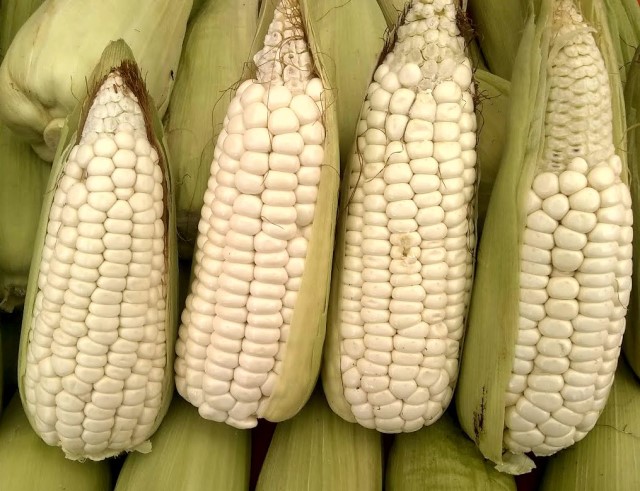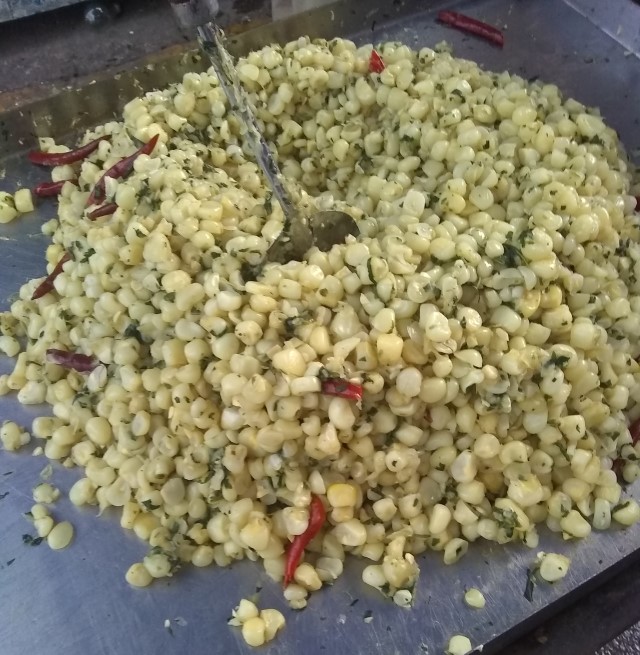My first encounter with Cacahuacintle was in a plate of menudo during my childhood. I couldn’t stand the pieces of cows’ stomachs in the sunday morning soup, but the big plump grains of corn swimming in the red concoction were a delicacy to me.

Cacahuacintle, a variety of corn indispensable to make pozole, is used in the north of Mexico to make menudo despite the protests from “experts” from Central Mexico who claim it´s exclusive of pozole. In my view, both uses of this curious corn are a gastronomic success and are not mutually exclusive.
The Pozole Jalisciense—recipe below—is the most widely known dish with cacahuacintle, but aside from the Jalisco red version, there is the green version from the State of Guerrero, and the white version from Central Mexico—recipe below. Protein wise, we can go for shrimp in Nayarit, lobster in Baja, beef in Sonora, chicken in Central Mexico, and pork almost anywhere else…

Generally known as maíz pozolero, it’s also consumed boiled or grilled on the cob, or enjoyed as esquites, Ízquitl in Náhuatl—from Icehqui to toast on a griddle—a preparation of boiled and sauteed corn that includes epazote, chile de árbol and lemon juice, and it is served on a cup topped with grated cheese, mayonnaise and ground chile piquín. Natives of Mexico only toasted the corn on a clay griddle with epazote and chiles since fat or dairy products were not part of their diet. It seems to me like a new ingredient is being added or replaced every year, because before butter was used instead of mayonnaise and no cheese was added. I now see sour cream invading new territories in some antojitos like sopes and tlacoyos. I hope it doesn’t reach corn on the cob.

Esquites made from cacahuazintle are a popular rainy afternoon treat during the corn harvest season from july to september. They are sold in street corners where elotes—corn on the cob—are sold boiled or grilled, I call it “the mobile corn shop”. This is the time to visit my favorite street corner vendor. While my produce supplier sells the cobs raw, I prefer to buy them cooked, take them home, degrain and sauté them on butter and epazote with a chile de árbol. Once ready, I season them with only salt and chile piquín. By the way, I like to grind chile piquín myself because what they sell as ground piquín could be any fiery dried red chile like de árbol or any of the imports from India and China but not the real McCoy.
Pozolli is the word in Náhuatl where pozole comes from and it means “foamy” due to the abundant foam it produces when cooking it. The natives observed this phenomenon that no other corn variety produced, this indicates its high starch content.

Making pozole is easy. Cacahuacintle is available precooked and clean, the rest is a simple stock of chicken, pork, fish, crustaceans or vegetables for a vegetarian version. In the U.S. it’s called hominy and can be found canned ready to use. The protein source could be pork or chicken and fancy versions run shrimp—recipe below—and even lobster. The vegetarian version could be made with commercial or wild mushrooms. The seasoning of the stock determines the color of the pozole: dried chiles for red; and tomatillos, pumpkin seeds and fresh herbs for the green version. The combinations are endless. And for a full pozole experience, there is a Feria del Pozole every year by the end of november in Morelia, Michoacán.
There are 64 varieties of corn in Mexico—59 indigenous—a noble plant that produces a staple from sea level to close to 13,000 ft above sea level. According to the Ministry of Agriculture, Mexico produces around 40,000 tons of maíz pozolero, 70% of that is produced in the State of México, neighboring Mexico City. White cacahuacintle is the predominant color but it can be found in pink and blue hues. An interesting characteristic to note is that the leaves of this curious corn hang downwards, which allows the plant to be tolerant to hail storms. Nature sure works wonders!
Growing up in a country where corn is abundant and consumed in many forms, you do not think much of it—or anything else on the house menu—since parents decide what is good for you. There are of course home cooking favorites but you don’t begin to imagine the wealth of ingredients and its multiple uses in Mexican cuisine. And if as a kid I only knew cacahuacintle in menudo, there was a world to discover later on, many other ways to enjoy this wonderful variety of corn.
Recipes for Pozole
Pozole Blanco
White Posole
The easiest version of pozole, it can be done in less than an hour.

Ingredients
- 2 Lbs. Cooked hominy
- 2 Lbs. Chicken in pieces
- 1 Onion in quarters
- 1 Garlic head cut in half across the cloves
- Fine herbs to taste
- Salt to taste
For the garnish
Sliced radishes, shredded lettuce, chopped onion, lemon in quarters to squeeze, oregano and powdered chile piquín or de árbol to taste. Corn tostadas on the side.
Instructions
- In a stock pot, boil the chicken, onion and garlic for 25 minutes. Remove the onion and garlic.
- Add the hominy, herbs and salt and boil for 10 minutes.
- Ready! Serve for breakfast, lunch or dinner.
Yield: six servings
Heat level: medium
Pozole Jalisciense: Red Posole from Jalisco
The most widely known pozole in Mexico, it’s considered representative from the State of Jalisco. One cannot leave Guadalajara before enjoying this wonderful dish.

Ingredients
- 2 lbs. cooked hominy
- 2 lbs. pork in pieces
- 1 onion in quarters
- 1 garlic head cut in half across the cloves
- Salt to taste
For the sauce
- 3 chiles guajillo seeded, deveined optional
- 1 chile ancho seeded, deveined optional
- 1 to 2 chiles de árbol (optional)
- ½ onion
- 1 garlic clove
- Salt to taste
For the garnish
Radishes sliced, shredded lettuce, chopped onion, lemon in quarters to squeeze, oregano and powdered chile piquín or de árbol to taste. Corn tostadas on the side.
Instructions
- In a stock pot, boil the pork, onion and garlic for 25 minutes. Remove the onion and garlic and throw it in the blender. Reserve.
- Soak the chiles in hot water for 15 minutes and throw them in a blender along with the onion, garlic and salt with enough water from the soaking pot to make a thick sauce.
- Add the sauce to the stock pot. Add the hominy, and salt and boil for 10 minutes.
- Serve and garnish on the table. Enjoy!
Yield: six servings
Heat level: medium
Pozole Verde de Camarón: Green Posole with Shrimp
This dish is an idea I had while on vacation in the State of Nayarit where shrimp is abundant and I remembered the green pozole from the State of Guerrero. It worked!

Ingredients
- 1 ½ lbs. cooked hominy
- 2 lbs. fresh shrimp
- 1 onion in quarters
- 1 garlic head cut in half across the cloves
- Fine herbs to taste
- Salt to taste
For the sauce
- 8 oz. pumpkin seeds
- 1 lb. tomatillo
- 8 oz. spinach
- Sprig of cilantro
- ½ onion
- 1 garlic clove
- Salt to taste
For the garnish
Slices of avocado, lemon in quarters to squeeze, oregano and chopped chile serrano to taste. Corn tostadas on the side.
Instructions
- In a stock pot, boil the shrimp, onion and garlic for 10 minutes. Remove the onion and garlic and throw them in the blender. Remove the shrimp and cut heads and tails and put them in the blender. Reserve.
- Boil the tomatillos for five minutes and throw them in the blender along with the spinach, cilantro, onion, garlic and salt. Reserve.
- Toast the pumpkin seeds lightly, let them cool off and add them to the blender. Using some shrimp stock, run the blender to make a thick sauce.
- Add the sauce to the stock pot. Add the hominy, herbs and salt and boil for 10 minutes.
- Serve and garnish on the table. Enjoy!
Yield: six servings
Heat level: medium






